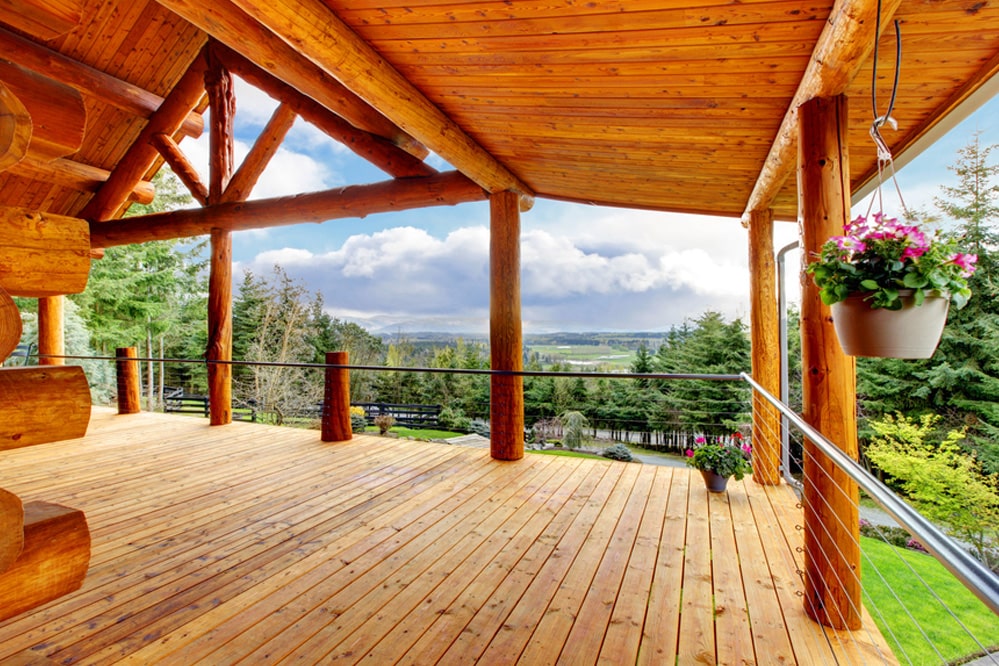We have seen the last of winter and with the arrival of warm weather, it is time for a little spring cleaning. Now is a good time to go out and perform an inspection for maintenance on your log home. In order to help you complete all of your maintenance items, it is best to be systematic and follow a checklist of items to complete.
Here are some recommendations for caring for your log home this time of year:
Inspect Your Logs
Though wall logs usually have some measure of roof protection overhead, by the time spring arrives, your log walls might have endured months of freezing and thawing or prolonged periods of rain and cold, which all take a toll on wood and seals.
Examine potential problem areas needing attention like log rails and rail posts. Sometimes log rails even if they are protected by porch roofs above, are often directly exposed to the elements. With such constant pounding from ultra-violet rays, snowstorms and wind, railings are often one of the first components of a log home to begin to fail. Watch for up-facing checks and consider having them sealed to prevent water intrusion.
Likewise, the base of porch posts can often see a greater weather exposure rain and UV rays seldom fall in an exclusively vertical manner and down low the posts are less protected from the roofline above. Wall logs most often are elevated above the ground but posts are regularly mounted directly to a hard surface such as deck or patio material and it’s the resulting water splash that, over time, can create a potentially troubling situation. Be sure to inspect these areas carefully for possible development of rot and create a more aggressive plan for maintaining the protective finish.
With rail posts you need to watch for porous end grain that seeks to absorb moisture more than any other part of the log. There is chance of tangential shrinkage which causes checks to open up and funnel water deep into the log, where it is difficult for the moisture to evaporate. Third, the horizontal surface itself lacks the ability to shed water complicating the first two issues.
Trim Vegetation
Landscaping that is too close to the home can potentially be damaging to a log home. The lower log courses of your walls can experience greater weather exposure and the effects of vegetation around it can add to the damage, as it limits air circulation. Plants and shrubs tend to shade and trap moisture in an area where you don’t want it. Use common sense to trim back the shrubbery as far as possible.
Inspect Your Sealants
Review any applied sealants including caulking and chinking. Make sure that no new significant skyward-facing checks have appeared or that previous applications have torn or pulled away from their bonding surfaces. Check caulk and chinking joints between logs and around windows and doors for areas that may have torn loose or stretched during the winter months.
Check Your Gutters
Gutters and downspouts are central to maintaining a dry basement, which might have been clogged with ice, snow and leaves for several weeks. Clogged gutters, or gutters that do not extend far enough to capture all cascading rainfall from the roof, will concentrate water exposure and limit the ability of your logs to dry out. If not immediately addressed, such long term exposure will be quite negative in its effects.
Wash Your Logs
Over time, your home’s logs will collect dust, pollen, and good old-fashioned grime that can set into your log finish and actually develop damaging mildew. To prolong the life of your log home finish, wash it with an ecologically-sound cleaning solution and mild scrubbing tools. The benefits of an annual wash may be significant for your log house.
Inspect Your HVAC
With the advent of spring, it is important to inspect your HVAC system and prepare it for cooling your home this coming summer. Hire a professional to determine if the unit’s coolant charge is correct. Change filters and shift registers from their heating to cooling settings. Many systems include duct dampers that have winter and summer positions.
You can easily adopt these recommendations to avoid potential problems for your log home. However, should you require an application of a new finish or other protective materials, please do not hesitate to schedule an inspection and obtain a free quote for services from Performance Log Home (800) 781-2551.


